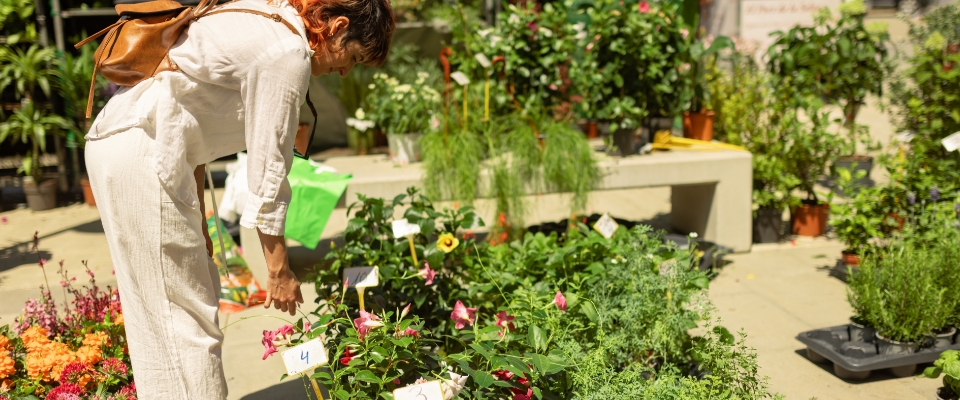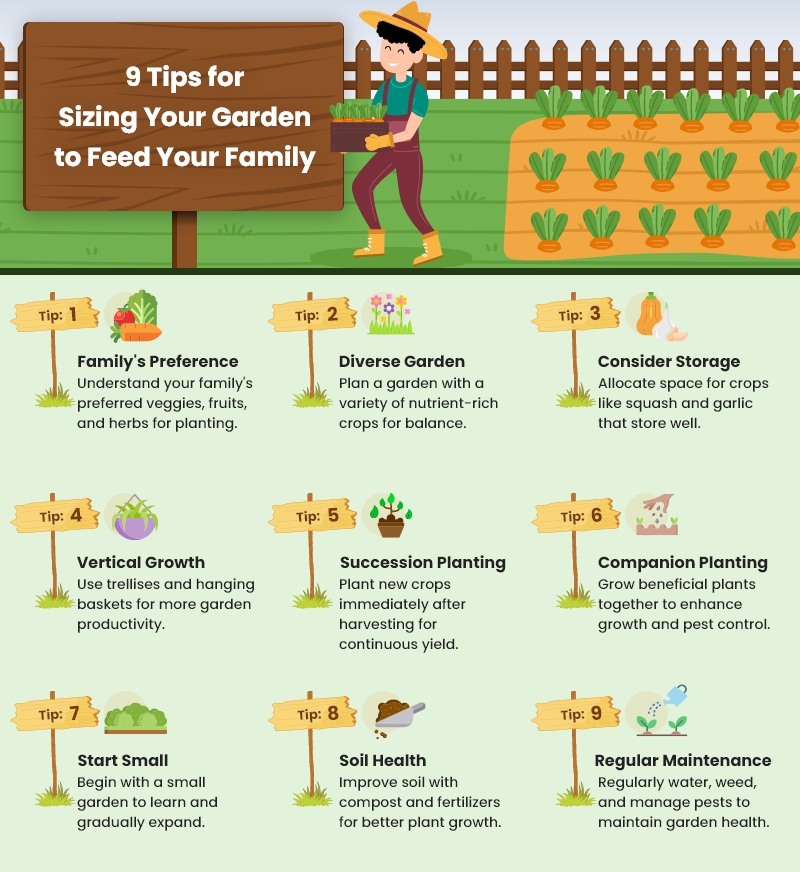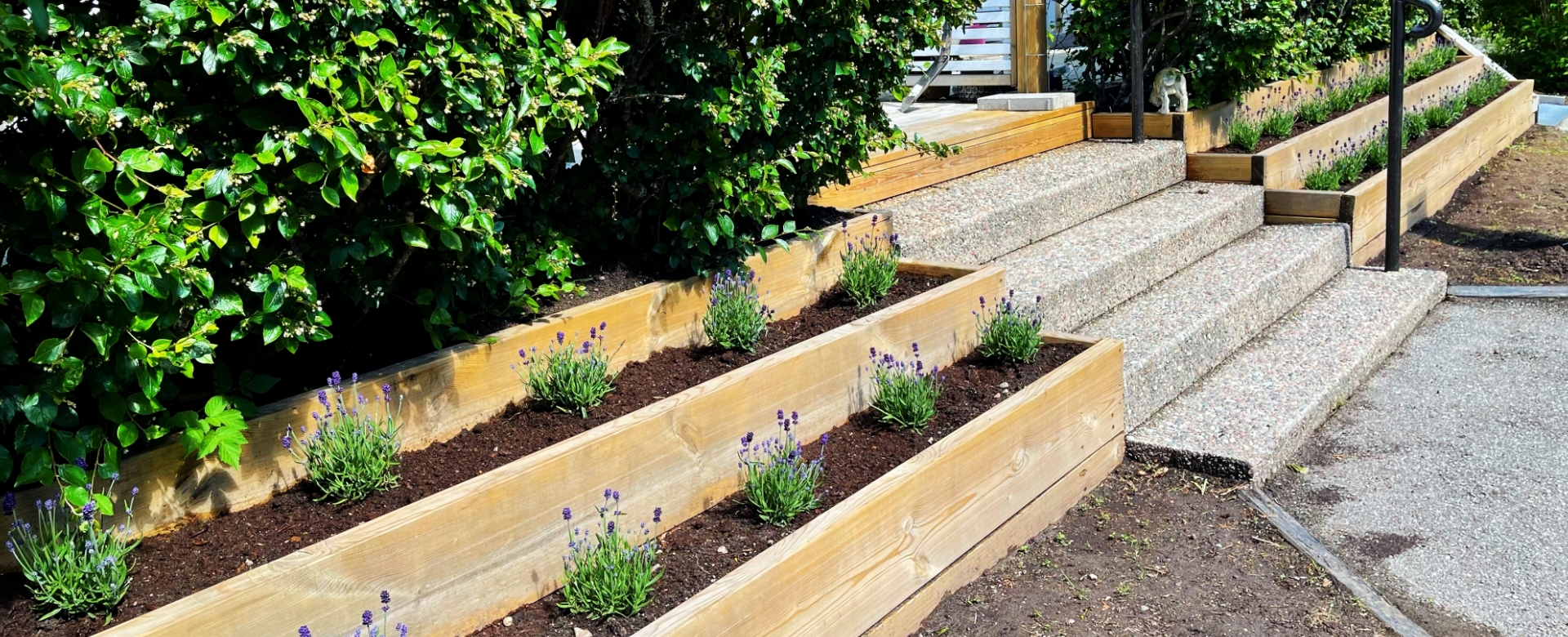Determining the right garden size is essential in ensuring your garden experience is enjoyable and productive. Whether you have a cozy garden plot or a sprawling backyard, this helpful guide will help you customize your garden to fit your family’s dietary needs.
Join us as we explore how to determine the optimal size of a garden to ensure your gardening experience is both productive and enjoyable. We will also help you learn how to balance space, effort, and yield to create a thriving garden that will produce fresh veggies all summer long. We will also learn about vital factors that make your gardening experience productive and enjoyable.
Significance of Choosing the Right Garden Size
Selecting the right garden size for your family is about maintaining a perfect balance between available space, the time you can commit to gardening, and your family’s food requirements.
Pro Tip. Start with a manageable small garden size and expand it when you become comfortable with maintaining it. With proper planning and gardening techniques, even a small garden will yield a bountiful harvest. Additionally, within a season or two, you can expand and begin producing more veggies to feed your whole family.
Which Factors to Consider When Deciding on a Garden Size?
Deciding on a garden size to feed your family involves a few key factors: Your available space, drainage, and time available.
A huge garden, for example, might seem like a good idea. However, if you go too big too fast, your garden will quickly become untenable and overgrown. Instead, first think about the number of family members, which vegetables to grow, and how well you can store vegetables for future use. All this influences the garden size to feed your family.
Here are some factors to consider:
Space Availability
The size of the area where you plan to create your garden significantly impacts its overall design and functionality. You need to measure the available space to determine what type of garden size you can fit. Vertical gardens or container gardening are best suitable for smaller spaces. For large spaces, raised beds or in-ground gardens are best.
Drainage
A proper drainage system is essential to maintain a healthy garden. You need to determine the soil’s ability to drain water. Clay soil retains water for a long time, while sandy soil drains water quickly. Soil amendments might be required to improve soil drainage. Areas with poor drainage might need raised beds or swales to prevent issues like root rot and waterlogging.
Family Size and Needs
Consider how many family members will use the garden and how it will meet their requirements. A large family will require more space for food production. If you have a small family, then you can go for a low-maintenance aesthetic garden.
Customize the garden according to your family’s interests, whether it would be a scenic retreat for relaxation or a functional space for growing herbs and vegetables. Ensure the garden size is safe and accommodates the gardening process without compromising plant health.
Garden Design
The garden design you plan will influence its aesthetics and usability. Decide on a garden theme that meets your personal taste and complements your surrounding environment.
Plan for different zones or features like seating areas, pathways, water features, vegetable patches, balancing form, and function. Select plants that blend well with your garden design, climate, and soil conditions of your place. Consider seasonal variations to maintain year-round interest and color.
Budget
Your budget will determine the scope and quality of your garden project. Consider the cost of plants, materials, soil amendments, and hardscaping elements like patios, pathways, or fences.
Consider long-term maintenance costs, including water, fertilizers, pest control, and plant/material replacement. Consider budget-friendly options like starting plants from seeds, recycling materials, prioritizing essential features first, and adding others over time.
Time and Maintenance
Evaluate how much time and effort you can dedicate to maintain your garden space. Decide the time and maintenance of your gardening schedule and ability to perform different gardening tasks regularly. Some gardens require more frequent upkeep than others. Opt for plants and garden designs that suit your maintenance requirements.
To reduce the upkeep of your garden, opt for automated irrigation systems, perennials, and drought-tolerant plants. Also, decide if you want professional assistance for initial setup or ongoing maintenance, as this will impact time and budget.
Different Garden Size to Feed Your Family

Deciding about the garden size to feed your family depends on how many people you are feeding and whether you are making plans for summer meals or year-round food. Crop yields vary widely, like opinions regarding how much produce is required to feed your family. Let us understand it with the breakdown of garden sizes and estimates on how much you can contribute to feed your family of four.
Beginner Gardeners (under 100 square feet)
If you are new to gardening, the best size to start your endeavor is a 10′ x 10′ garden (100 square feet), plant 5 of your favorite veggies, and purchase 3-5 plants of each one.
Doing this will give you a modest harvest for summer suppers and will be easy on the maintenance part. This garden size is ideal for newbies and those with limited gardening space. It also allows you to focus on growing a few of your favorite vegetables.
Established Gardeners (300-500 square feet)
Once you become comfortable with gardening endeavors, increase your garden size to 300-500 square feet. This garden size is sufficient to feed a family of four during summers with little extra left over to share.
A general guideline for creating a summer vegetable garden is to plan for about 100 square feet per person. This garden size allows you to grow various veggies by following some preservation methods.
Abundant Harvest (500-1000 square feet and more)
This garden size can feed a family of four throughout the year, with the potential to share the surplus, which can be shared with friends or preserved for off-season use. This garden size helps produce a significant amount of food sufficient to feed a family of 4.
With a large garden, you can grow a diverse range of fruits, vegetables, some herbs and small-scale proteins (like beans or legumes) that contribute to your family’s nutritional requirements. Careful planning and efficient use of space are required to make the most of this garden size. Strategic planning and using the best planting techniques for your veggies can extend the growing season. Besides, consider increasing the variety of crops grown in your garden.
9 Tips for Sizing Your Garden to Feed Your Family

Using garden size in the best way to feed your family involves more than just the physical dimensions of your garden plot. It involves maximizing your garden space and implementing innovative gardening practices to enjoy a bountiful harvest.
Below are 9 valuable tips to sizing your garden to feed your family:
1. Family’s Preference
The first step in sizing your garden to feed your family is to understand your family’s preferences, i.e., what they love to eat. Make a separate list of vegetables, fruits, and herbs commonly used in your household. This will guide you in your planting choice and help you allot space based on the crops that are useful to your family.
2. Plan for a Diverse Garden
It is a good idea to plan a diverse garden that provides a range of nutrients and flavors. Plant a mix of crops that will successfully fulfill your family’s nutrient and dietary requirements. For instance, planting nutrient-filled leafy greens like Kale and Spinach alongside high-calorie crops like potatoes helps strike the balance.
3. Consider Storage
When planning the size of your family’s garden, consider the amount of produce you want to store for later consumption. Certain crops like winter squash, garlic, and onion, can be stored for several months, so provide appropriate space for them in your garden layout.
4. Use Vertical Space
Vertical gardening is a technique that increases your garden’s productivity. Grow vining plants like peas, cucumbers, and beans on trellises or along fences. You can also consider hanging baskets and tiered containers to provide extra room for herbs and other small crops.
5. Succession Planting
Practice succession planting to enjoy a constant supply of fresh produce in your garden. This involves planting a new crop as soon as the previous one is harvested. Quick-growing crops like radishes and lettuce can be followed by longer-season plants like tomatoes.
6. Companion Planting
Companion planting involves growing crops together that benefit each other in some way. Some plants protect your main crop from pests, while others improve soil fertility. For instance, planting tomatoes alongside marigolds can help deter pests.
7. Start Small
If you are a novice at gardening, begin with a small garden plot. It will teach you about all important aspects of gardening, plant-growing techniques, and practices. With the passage of time, you will gain experience, expertise, and confidence in gardening and then you can expand your garden in subsequent seasons.
8. Soil Enrichment
Healthy soil forms the primary basis of a productive garden. Invest time improving your soil with organic matter, compost, and other suitable fertilizers. Well-nourished soil yields healthy plants, leading to better harvest.
9. Regular Maintenance
You should dedicate time to your garden’s upkeep. Established plants require proper maintenance. You should follow certain gardening practices, like regular watering, weeding, and pest management, to prevent problems that can negatively impact your harvest. You should monitor your garden regularly to detect and deal with issues in the initial stage.
Conclusion
Creating a garden to feed your family requires proper planning, a bit of experimentation, and a lot of patience. While there is no one-size-fits-all answer to the question of how big a garden size is appropriate for your family, you can customize your garden based on your family’s specific dietary needs and preferences.
FAQs
As a thumb rule, you should start with a small garden and add to it if necessary. An ideal starting size for a garden is between 75-100 square feet.
To calculate the garden size, multiply the length by the width to determine a square or rectangle's square foot or area. Find the square foot of the garden size and multiply the length and width of the area. Make sure to keep your units the same (in feet or inches).
A conservative estimate suggests that about 200 square feet of raised garden beds are suitable for a season's worth of fresh produce for a single person. As per this estimate, an 800-1200 square feet garden will yield enough fruits and vegetables for a family of four.
There are no rules set that help decide the average home garden size. Here are a few guidelines for the garden area by the square foot for families:
- For individuals, 100 square feet of garden size is ideal.
- For two people, 200 square feet of garden size is ideal.
- For an average family of 3-4 members, 300-500 square feet of garden size is ideal.
- For a large family of 5+ members, 600-800 square feet of garden size is ideal.
- For an extensive large family of 8+ members, 1000+ square feet of garden size is ideal.
To maximize your garden space, use vertical gardening with trellises and wall planters, and opt for high-yield, compact plants. Practice companion planting to use soil nutrients and ward off pests efficiently.




